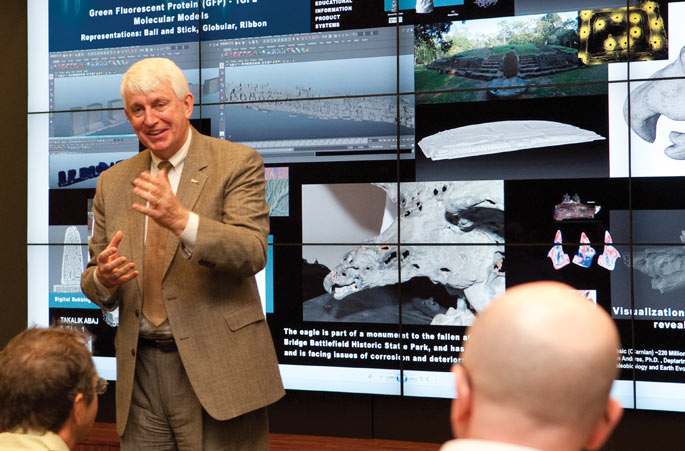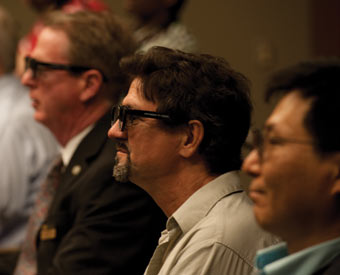Feature
Extreme Focus
The 3D Advanced Visualization Center is the only one of its kind in the nation.
| USF News

The Advanced Visualization Center is a resource for student research and faculty instruction. Above, Provost Ralph Wilcox introduces the new device to the university community at a preview event in April.
Photo by Aimee Blodgett | USF News
Imagine taking the tiny machines that are developed in nanotechnology — some smaller and thinner than a human hair — and being able to manipulate them in ways never done before.
Think about what could be learned by examining an ancient artifact from Central America from every angle to study exactly what its creators were trying to communicate, without actually having to remove the treasure from its home country. Or consider what could be discovered by taking massive amounts of data and transforming it from numbers on a spreadsheet into meaningful displays that lead to discoveries.
That's exactly what will happen when USF's new Advanced Visualization Center is used by students and faculty, merging some of the best new digital 3D technology with learning in a way that's never been done before on campus.
"Visualization is not about seeing, it's about thinking," says Howard Kaplan, USF's advanced visualization specialist, who helped open the student technology fee-funded center this spring.
"I think it's a place for definitive research and discovery."
The center is located in USF's Physics Building and is available for use by all disciplines. In addition to the large video wall made up of 16 3D monitors, the center is connected to USF's high performance computing clusters, to transform massive data sets into cutting-edge information. With a resolution of 20 million pixels, the video wall is twice the resolution of an IMAX screen.

Faculty members wear 3D glasses to experience the level of image detail provided by the LCD video wall. Named "BullsEye," the wall can display multiple images, video and web content simultaneously.
Photo by Aimee Blodgett | USF News
"The real big thing that sets us apart is that it's totally interactive," Kaplan says. "The way we built it you can use mobile devices, you can use wireless devices to power it, so that way you can actually have a more immersive experience than just viewing video or images. You can interact with your data."
The center has already been in use working with USF anthropologists who use advanced digital scanners to collect data on Mayan monuments and other historical ruins in need of restoration. The center is open to all departments on campus, with applications from every part of the campus — from arts to sciences.
"The biggest highlight is being able to help students with their data and see their reaction when they've done all this work and research and now they have something almost physical that they can interact with," Kaplan says.